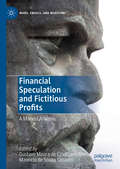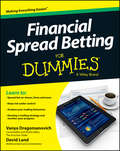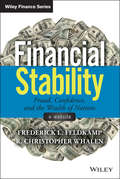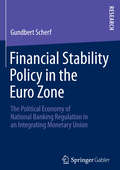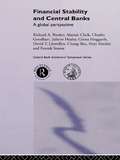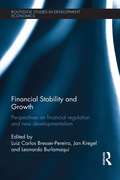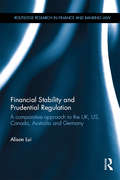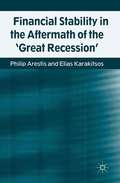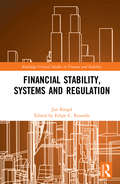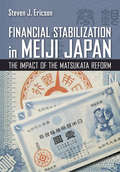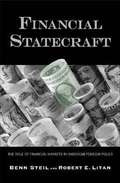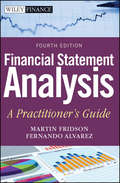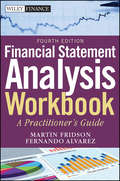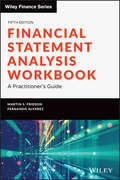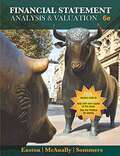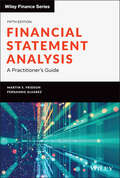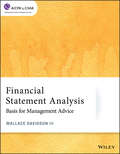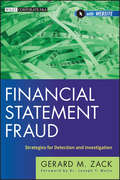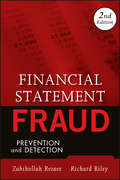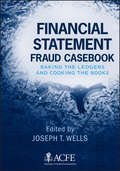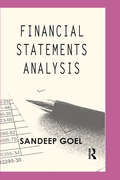- Table View
- List View
Financial Speculation and Fictitious Profits: A Marxist Analysis (Marx, Engels, and Marxisms)
by Gustavo Moura de Cavalcanti Mello Mauricio de Souza SabadiniThis book provides an original account of financialisation and outlines the creation of fictitious profits as a basis to describe the present phase of capitalist accumulation in the neoliberal era. Making innovative theoretical elaborations on Marx’s notion of fictitious capital, Financial Speculation and Fictitious Profits offers a dialectic analysis of the increasing financialization during this crisis-ridden period based on the original concepts of fictitious profit and fictitious wealth. Combining the most important research from over twenty years of scholarly inquiry with groundbreaking new studies, Financial Speculation and Fictitious Profits is more than a collection of texts by political economists on a contemporary topic; it is a synthesis of an intense process of academic production that began with work of Karl Marx and has resulted in the formulation of a differentiated interpretative perspective on the contemporary evolution of capitalist crisis.
Financial Spillovers to Emerging Markets During the Global Financial Crisis
by Nathaniel Frank Heiko HesseA report from the International Monetary Fund.
Financial Spread Betting For Dummies
by Vanya Dragomanovich David LandKeen to try your hand at financial spread betting? Perhaps you’re already investing in shares and looking for other strategies to maximise your profits. Or maybe you’ve just heard the buzz and want to find out what all the fuss is about. Financial spread betting is an exciting tool for investors - a way to make money in up or down markets, without ever having to own a share. Best of all? It is tax and commission free. Perfect for smart, savvy investors like yourself! Financial Spread Betting For Dummies is your one-stop introduction to the world of spread betting. Packed with advice and examples, this guide tells you: How to get started Where you can spread bet Strategies for successful betting How to evaluate risks (of which there are many!) What mistakes to avoid
Financial Stability
by R. Christopher Whalen Frederick L. FeldkampApplying the Lessons of History to Understanding Fraud Today and TomorrowFinancial Stability provides a roadmap by which the world can anticipate and avoid future financial disruptions. This unique discussion of past and present financial events offers new insights that explain economic, political, and legal antecedents of financial crises in Western markets. With a detailed discussion of the history of finance, this book shows modern investors and finance professionals how to learn from past successes and failures to gauge future market threats.Readers will gain new insight into the antecedents of todays financial markets and the political economy that surrounds them. Armed with this knowledge, they will be able to craft a strategy that steers away from financial disorder and toward maximum stability. Coverage includes discussion of capital, forecasting, and political reaction, and past, present, and future applications within all realms of business. The companion website offers additional data and research, providing a complete resource for those seeking a better understanding of the risk at hand.As the world struggles to emerge from the latest financial crisis, professionals in finance, the law and other disciplines, and the people they advise, are searching for understanding to avoid future crises. Financial Stability argues that the best lessons are learned from our own mistakes, and that the ability to look ahead depends upon our willingness to look back. Readers will:Review the historical laws, practices, and outcomes that shaped the modern day financial markets of the great western economiesUnderstand the theory of financial stability, the roles of law and transparency, and the importance of action to punish fraud in order to prevent future contagionWork through the theoretical proofs in terms of math, law, accounting, economics, philosophy, and international tradeBuild a strategy for the future with consideration toward needs, sources, balance, and learning from past mistakesEverywhere around the globe, at all points in history, financial crises have always been rooted in the confluence of politics, finance, and law. Financial Stability puts the latest global financial crisis in perspective, highlighting the lessons we have already learned, and those we need to internalize today.
Financial Stability Policy in the Euro Zone
by Gundbert ScherfDue to the lack of political salience that financial stability policy enjoys in tranquil economic times, this policy field lends itself particularly well to capture - the more so the more important the role of banks is in the financial system. Gundbert Scherf's research focuses on this nexus between integrated banking, supranational monetary policy and national banking regulation. He finds that national level differences in financial systems and related institutions explain and drive variation in regulatory financial stability policy across countries.
Financial Stability and Central Banks: A Global Perspective (Central Bank Governor's Symposium Ser.)
by Charles Goodhart Richard A. Brealey Peter Sinclair Alastair Clark Juliette Healey Glenn Hoggarth David T. Llewellyn Chang Shu Farouk SoussaAn overview of present day thought on the very topical subject of financial stability and central banking. The papers, written by leading researchers, provide a highly informed account of contemporary policy issues and explore the legal, regulatory, managerial and economic issues that affect central banks.
Financial Stability and Growth: Perspectives on financial regulation and new developmentalism (Routledge Studies in Development Economics #108)
by Leonardo Burlamaqui Jan Kregel Luiz Carlos Bresser-PereiraThe 2008 global financial crisis took the world by surprise, not least because politicians, businessmen and economists believed that they had learned crucial lessons from the Great Depression of the 1930s. As a direct result of deregulated financial markets, financial crises occurred in both developed and developing economies. However, this volume argues that in the most recent crisis developing countries suffered less, and that financial policy and regulation played a crucial part in this. The contributors to this volume explore the alternative development paradigm that has been gaining credence since the Asian crisis, known as new developmentalism. New developmentalism is embodied in the following principles: exchange rate responsibility or growth with domestic savings, fiscal responsibility, and the assignment of a strategic role for the state. New developmentalism is a set of values, ideas, institutions and economic policies through which, in the early 21st century, developing countries have sought to catch up with developed countries. This book examines the global financial crisis, the financial regulatory problem, with particular emphasis on Brazil, and the alternative policies that derive from new developmentalism. This volume will be of interest to scholars and policymakers working in the areas of globalization, financial regulation and development studies.
Financial Stability and Prudential Regulation: A Comparative Approach to the UK, US, Canada, Australia and Germany (Routledge Research in Finance and Banking Law)
by Alison LuiFinancial stability is one of the key tenets of a central bank’s functions. Since the financial crisis of 2007-2009, an area of hot debate is the extent to which the central bank should be involved with prudential regulation. This book examines the macro and micro-prudential regulatory frameworks and systems of the United Kingdom, Australia, the United States, Canada and Germany. Drawing on the regulator frameworks of these regions, this book examines the central banks’ roles of crisis management, resolution and prudential regulation. Alison Lui compares the institutional structure of the new ‘twin-peaks’ model in the UK to the Australian model, and the multi-regulatory US model and the single regulatory Canadian model. The book also discusses the extent the central bank in these countries, as well as the ECB, are involved with financial stability, and argues that the institutional architecture and geographical closeness of the Bank of England and Financial Policy Committee give rise to the fear that the UK central bank may become another single super-regulator, which may provide the Bank of England with too much power. As a multi-regional, comparative study on the importance and effectiveness of prudential regulation, this book will be of great use and interest to students and researchers in finance and bank law, economics and banking.
Financial Stability in Dollarized Economies
by Anne-Marie Gulde Alain Ize David S. HoelscherA report from the International Monetary Fund.
Financial Stability in the Aftermath of the �Great Recession�
by Philip Arestis Elias KarakitsosThe financial crisis and the ensued 'great recession' are primarily caused by the excessive liquidity that was created in the last thirty years or so of inequality that benefited greatly the financial sector, deregulation and financial liberalisation as well as financial innovation.
Financial Stability, Economic Growth and Sustainable Development (Routledge Studies in the European Economy)
by Marc Baudry Sławomir Ireneusz Bukowski Marzanna Barbara LamentFollowing multiple global crises, there is an urgent need to review our economic and financial paradigms to improve outcomes for the three pillars of sustainable development: economic, social, and environmental. In response, various strands of new economic thinking have emerged such as degrowth, the collaborative economy, solidarity economy, sharing economy and social entrepreneurship. This book explores the various economic and financial dimensions of sustainable development drawing on new and existing theories.This comprehensive book is divided into four sections, each presenting the results of a team of international researchers, tackling the issue from a global, macroeconomic, and microeconomic approach. The first part examines the determinants of sustainable development in the global economy, while the second looks at enterprise in a sustainable world. The third section analyses the financial markets and the fourth addresses economic policy and sustainable development. A wide array of sustainability concerns are discussed in-depth, from analysing changes in environmental social, and governance reporting and assessing their impact on the information systems and reporting of economic entities; exploring the transition to 'Industry 5.0', and how technological innovation can be deployed to support a better fit and 'win-win' interaction between industry and society, shifting focus from economic and technological factors to important environmental and social dimensions.The monograph is an invaluable resource for scholars, researchers, and students of applied, development, growth, resource, and welfare economics. The policy recommendations will be of benefit to policymakers concerned with issues of sustainable development generally and the Sustainable Development Goals specifically.
Financial Stability, Systems and Regulation (Routledge Critical Studies in Finance and Stability)
by Jan KregelEver since the 2007–8 global financial crisis and its aftermath, Hyman Minsky’s theory has never been more relevant. Throughout his career, Jan Kregel has called attention to Minsky’s contributions to understanding the evolution of financial systems, the development of financial fragility and instability, and designing the financial structure necessary to support the capital development of the economy. Building on Minsky, Kregel developed a framework to analyze how different financial structures develop financial fragility over time. Rather than characterizing financial systems as market-based or bank-based, Kregel argued that it is necessary to distinguish between the risks that are carried on the balance sheets of banks and other financial institutions. This volume, brought together by Felipe C. Rezende, highlights these major contributions from Kregel through a collection of his influential papers from various journals and conferences. Kregel’s approach provides a strong theoretical background to understand the making and unfolding of the crisis and helps us to draw policy implications to improve financial stability, and suggest an alternative financial structure for a market economy. In this book, his knowledge is consolidated and the ideas he puts forward offer a path for future developments in economics which will be of great interest to those studying and researching in the fields of economics and finance.
Financial Stabilization in Meiji Japan: The Impact of the Matsukata Reform (Cornell Studies in Money)
by Steven J. EricsonWith a new look at the 1880s financial reforms in Japan, Steven J. Ericson's Financial Stabilization in Meiji Japan overturns widely held views of the program carried out by Finance Minister Matsukata Masayoshi. As Ericson shows, rather than constituting an orthodox financial-stabilization program—a sort of precursor of the "neoliberal" reforms promoted by the IMF in the 1980s and 1990s—Matsukata's policies differed in significant ways from both classical economic liberalism and neoliberal orthodoxy.The Matsukata financial reform has become famous largely for the wrong reasons, and Ericson sets the record straight. He shows that Matsukata intended to pursue fiscal retrenchment and budget-balancing when he became finance minister in late 1881. Various exigencies, including foreign military crises and a worsening domestic depression, compelled him instead to increase spending by running deficits and floating public bonds. Though he drastically reduced the money supply, he combined the positive and contractionary policies of his immediate predecessors to pull off a program of "expansionary austerity" paralleling state responses to financial crisis elsewhere in the world both then and now.Through a new and much-needed recalibration of this pivotal financial reform, Financial Stabilization in Meiji Japan demonstrates that, in several ways, ranging from state-led export promotion to the creation of a government-controlled central bank, Matsukata advanced policies that were more in line with a nationalist, developmentalist approach than with a liberal economic one. Ericson shows that Matsukata Masayoshi was far from a rigid adherent of classical economic liberalism.
Financial Statecraft: The Role of Financial Markets in American Foreign Policy
by Benn Steil Robert E. LitanAs trade flows expanded and trade agreements proliferated after World War II, governments--most notably the United States--came increasingly to use their power over imports and exports to influence the behavior of other countries. But trade is not the only way in which nations interact economically. Over the past two decades, another form of economic exchange has risen to a level of vastly greater significance and political concern: the purchase and sale of financial assets across borders. Nearly $2 trillion worth of currency now moves cross-border every day, roughly 90 percent of which is accounted for by financial flows unrelated to trade in goods and services--a stunning inversion of the figures in 1970. The time is ripe to ask fundamental questions about what Benn Steil and Robert Litan have coined as "financial statecraft," or those aspects of economic statecraft directed at influencing international capital flows. How precisely has the American government practiced financial statecraft? How effective have these efforts been? And how can they be made more effective? The authors provide penetrating and incisive answers in this timely and stimulating book.
Financial Statement Analysis
by Martin S. Fridson Fernando AlvarezAn updated guide to the essential discipline of financial statement analysisIn Financial Statement Analysis, Fourth Edition, leading investment authority Martin Fridson returns with Fernando Alvarez to provide the analytical framework you need to scrutinize financial statements, whether you're evaluating a company's stock price or determining valuations for a merger or acquisition.This fully revised and up-to-date Fourth Edition offers fresh information that will help you to evaluate financial statements in today's volatile markets and uncertain economy, and allow you to get past the sometimes biased portrait of a company's performance.Reflects changes in the financial reporting landscape, including issues related to the financial crisis of 2008-2009Provides guidelines on how to interpret balance sheets, income statements, and cash flow statementsOffers information for maximizing the accuracy of forecasts and a structured approach to credit and equity evaluationFilled with real-life examples and expert advice, Financial Statement Analysis, Fourth Edition will help you gain a firm understanding of the techniques that will help you interpret financial statements, which are designed to conceal more than reveal.
Financial Statement Analysis Workbook: A Practitioner's Guide (Wiley Finance #599)
by Martin S. Fridson Fernando AlvarezAll too often, financial statements conceal more than they reveal. Even after the recent economic crisis, those analyzing financial statements face serious new concerns and challenges. The Fourth Edition of Financial Statement Analysis skillfully puts this discipline in perspective, and now, with this companion Workbook, you can hone your skills and test the knowledge you've gained from the actual text, before putting them to work in real-world situations. Question-and-answer sections within this Workbook correspond to each chapter of Financial Statement Analysis, Fourth Edition. Part One (Questions) provides chapter-by-chapter fill-in-the-blank questions, as well as financial statement and computational exercises. They are designed to be thought-provoking and require analysis and synthesis of the concepts covered in the book. The answers to all questions, which can be found in Part Two, are provided in boldfaced italic type in order to facilitate the checking of answers and comprehension of material. By enhancing your understanding of financial statement analysis, you can begin to undertake genuine, goal-oriented analysis and prepare for the practical challenges of contemporary business. This reliable resource will help you achieve such a difficult goal and allow you to make more informed decisions—whether you're evaluating a company's stock price or determining valuations for a merger or acquisition.
Financial Statement Analysis Workbook: A Practitioner's Guide (Wiley Finance #79)
by Martin S. Fridson Fernando AlvarezThe helpful workbook to help practice assessing financial statements Financial statement analysis is essential as part of any well-organized financial portfolio. As a companion piece, Financial Statement Analysis Workbook: A Practitioner's Guide allows readers the opportunity to test and hone the skills put forward in Martin Fridson and Fernando Alvarez's Financial Statement Analysis, a resource devoted to providing the analytical framework necessary to make sense of the sometimes misleading numbers put forth by companies. Scrutinizing financial statements allows one to, for example, evaluate a company&’s stock price or determine merger or acquisition valuations. The Financial Statement Analysis Workbook, then, provides a pathway to become familiar with these methodologies in order to be prepared to use them in real-world scenarios. With the skills provided within, you can begin to undertake goal-oriented preparation for the practical challenges of contemporary business, and feel confident in your financial decision-making. This is aided by: Question-and-answer sections within this Workbook correspond to each chapter of Financial Statement Analysis Financial statement and computational exercises designed to require analysis and synthesis of concepts covered in the core text A full list of answers in the second half of the book that help explain pitfalls within the questions An essential tool for professional analysts, investors, and students, Financial Statement Analysis Workbook offers the perfect opportunity to help turn theory into reality.
Financial Statement Analysis and Valuation
by Peter Easton Mary Lea McAnally Gregory SommersIncorporates real company data throughout each module to reinforce important concepts and engage students. Teaches students how to read, analyze and interpret financial statements, footnotes, and nonfinancial disclosures for business decisions including profitability and credit risk analysis.
Financial Statement Analysis: A Practitioner's Guide (Wiley Finance #597)
by Martin S. Fridson Fernando AlvarezThe updated, real-world guide to interpreting and unpacking GAAP and non-GAAP financial statements In Financial Statement Analysis, 5th Edition, leading investment authority Martin Fridson returns with Fernando Alvarez to provide the analytical framework you need to scrutinize financial statements, whether you're evaluating a company's stock price or determining valuations for a merger or acquisition. Rather than taking financial statements at face value, you'll learn practical and straightforward analytical techniques for uncovering the reality behind the numbers. This fully revised and up-to-date 5th Edition offers fresh information that will help you to evaluate financial statements in today's volatile markets and uncertain economy. The declining connection between GAAP earnings and stock prices has introduced a need to discriminate between instructive and misleading non-GAAP alternatives. This book integrates the alternatives and provides guidance on understanding the extent to which non-GAAP reports, particularly from US companies, may be biased. Understanding financial statements is an essential skill for business professionals and investors. Most books on the subject proceed from the questionable premise that companies' objective is to present a true picture of their financial condition. A safer assumption is that they seek to minimize the cost of raising capital by portraying themselves in the most favorable light possible. Financial Statement Analysis teaches readers the tricks that companies use to mislead, so readers can more clearly interpret statements. Learn how to read and understand financial statements prepared according to GAAP and non-GAAP standards Compare CFROI, EVA, Valens, and other non-GAAP methodologies to determine how accurate companies' reports are Improve your business decision making, stock valuations, or merger and acquisition strategy Develop the essential skill of quickly and accurately gathering and assessing information from financial statements of all types Professional analysts, investors, and students will gain valuable knowledge from this updated edition of the popular guide. Filled with real-life examples and expert advice, Financial Statement Analysis, 5th Edition, will help you interpret and unpack financial statements.
Financial Statement Analysis: Basis for Management Advice (AICPA)
by Wallace Davidson IIIThis book presents financial statements as a set of dynamic instruments that can be used for accurate, relevant, and timely financial decisions. It focuses on the economic and financial conditions that cause statements to change and discover how businesses can manage liquidity, debt, and profitability. Plus, explore effect ratios, causal ratios, pro forma analysis, sustainable growth, and much more. Key topics covered include: valuation techniques, effect ratios, DuPont system for analyzing profitability, causal analysis. how to conduct a financial statement analysis, users of financial statements, forecasting sustainable growth, and bankruptcy prediction models.
Financial Statement Fraud
by Gerard M. ZackValuable guidance for staying one step ahead of financial statement fraudFinancial statement fraud is one of the most costly types of fraud and can have a direct financial impact on businesses and individuals, as well as harm investor confidence in the markets. While publications exist on financial statement fraud and roles and responsibilities within companies, there is a need for a practical guide on the different schemes that are used and detection guidance for these schemes. Financial Statement Fraud: Strategies for Detection and Investigation fills that need.Describes every major and emerging type of financial statement fraud, using real-life cases to illustrate the schemesExplains the underlying accounting principles, citing both U.S. GAAP and IFRS that are violated when fraud is perpetratedProvides numerous ratios, red flags, and other techniques useful in detecting financial statement fraud schemesAccompanying website provides full-text copies of documents filed in connection with the cases that are cited as examples in the book, allowing the reader to explore details of each case furtherStraightforward and insightful, Financial Statement Fraud provides comprehensive coverage on the different ways financial statement fraud is perpetrated, including those that capitalize on the most recent accounting standards developments, such as fair value issues.
Financial Statement Fraud
by Richard Riley Zabihollah RezaeePractical examples, sample reports, best practices and recommendations to help you deter, detect, and prevent financial statement fraudFinancial statement fraud (FSF) continues to be a major challenge for organizations worldwide. Financial Statement Fraud: Prevention and Detection, Second Edition is a superior reference providing you with an up-to-date understanding of financial statement fraud, including its deterrence, prevention, and early detection.You will findA clear description of roles and responsibilities of all those involved in corporate governance and the financial reporting process to improve the quality, reliability and transparency of financial information.Sample reports, examples, and documents that promote a real-world understanding of incentives, opportunities, and rationalizationsEmerging corporate governance reforms in the post-SOX era, including provisions of the SOX Act, global regulations and best practices, ethical considerations, and corporate governance principlesPractical examples and real-world "how did this happen" discussions that provide valuable insight for corporate directors and executives, auditors, managers, supervisory personnel and other professionals saddled with anti-fraud responsibilitiesExpert advice from the author of Corporate Governance and Ethics and coauthor of the forthcoming Wiley textbook, White Collar Crime, Fraud Examination and Financial ForensicsFinancial Statement Fraud, Second Edition contains recommendations from the SEC Advisory Committee to reduce the complexity of the financial reporting process and improving the quality of financial reports.
Financial Statement Fraud Casebook: Baking the Ledgers and Cooking the Books
by Joseph T. WellsA comprehensive look at financial statement fraud from the experts who actually investigated them. This collection of revealing case studies sheds clear insights into the dark corners of financial statement fraud. Includes cases submitted by fraud examiners across industries and throughout the world Fascinating cases hand-picked and edited by Joseph T. Wells, the founder and Chairman of the world's leading anti-fraud organization ? the Association of Certified Fraud Examiners (ACFE) ? and author of Corporate Fraud Handbook Outlines how each fraud was engineered, how it was investigated and how the perpetrators were brought to justice Providing an insider's look at fraud, Financial Statement Fraud Casebook illuminates the combination of timing, teamwork and vision necessary to understand financial statement fraud and prevent it from happening in the first place.
Financial Statement and Ratio Analysis
by Jacob Cohen Paul M. HealyPrepares students for financial ratio analysis.
Financial Statements Analysis: Cases from Corporate India
by Sandeep GoelFinancial analysis is integral to business sustainability in determining an organisation’s financial viability and revealing its strengths and weaknesses, a key requirement in today’s competitive business environment. In a first of its kind, Financial Statements Analysis: Cases from Corporate India: evaluates the financial performance and efficiency of various corporate enterprises in India; presents actual case studies from eight core sectors (in manufacturing and services) — construction, cement, steel, automobile, power, telecom, banking, and Business Process Outsourcing (BPO); examines the financial statements on parameters such as financial ratios (profitability, solvency, and liquidity), while appraising their operating efficiency, market potential and valuation; and investigates their implications for larger decision-making and policy recommendations. It will be an important resource for scholars, teachers and students of business and management, commerce, finance, and accounting. It will also appeal to corporate trainers, senior executives and consultants in related fields.
